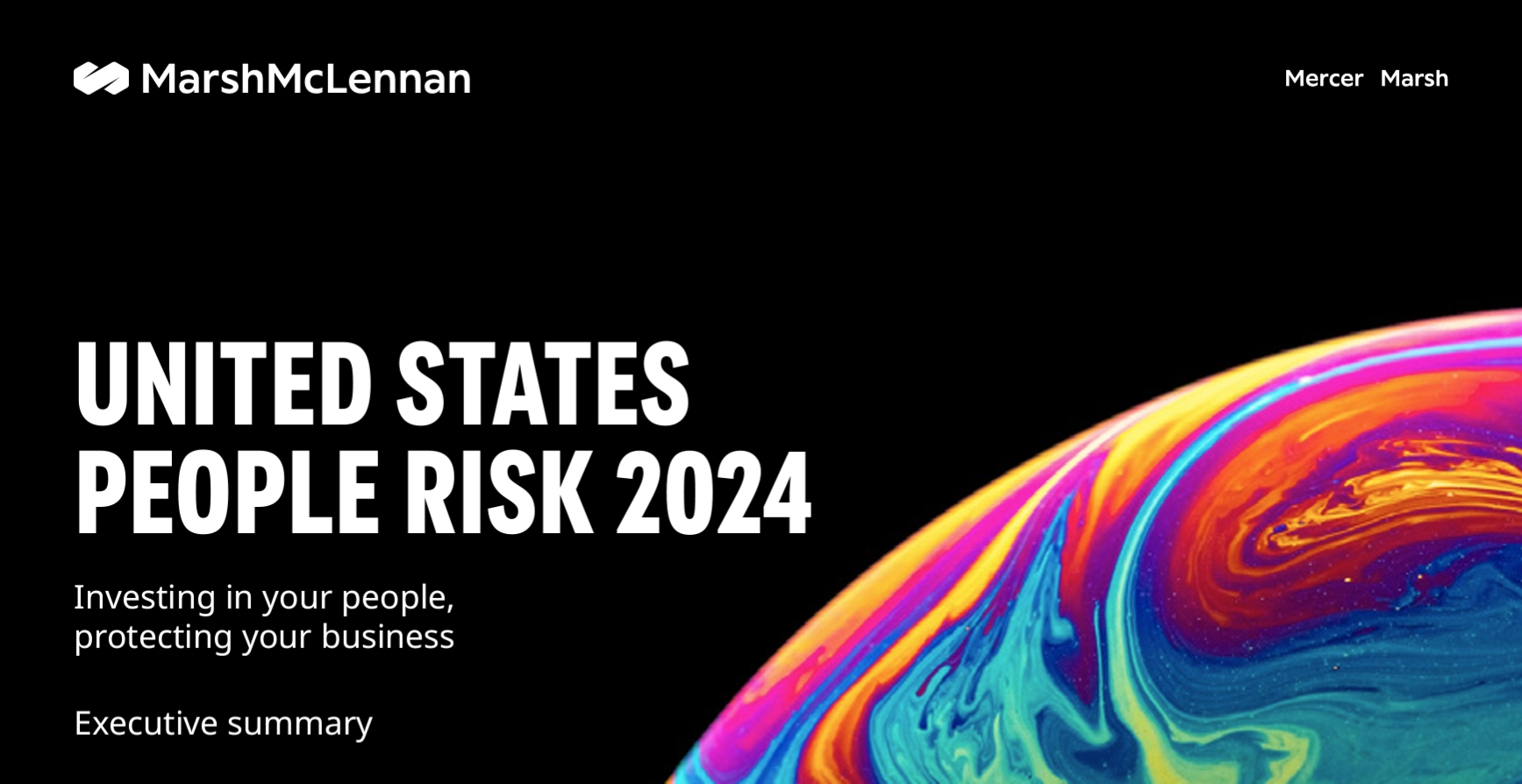Leadership, benefits, and technology risks top of mind for risk and HR professionals surveyed by Mercer and Marsh
The US People Risk 2024 Report by Mercer and Marsh, businesses of Marsh McLennan, highlights the top people risks identified by over 1,000 risk and HR professionals nationwide. The report reveals that ineffective leadership, improper rewards decision making, and increasing health and benefit costs are the primary concerns for organizations today. Additional risks include lack of cybersecurity knowledge and mismanagement of AI. The report underscores the importance of a proactive and collaborative approach to people risk management to help businesses thrive in a complex risk environment.

NEW YORK–Mercer and Marsh, businesses of Marsh McLennan (NYSE: MMC), the world’s leading professional services firm in the areas of risk, strategy and people, released today their US People Risk 2024 Report.
Based on responses from more than 1,000 risk and HR professionals nationwide, the survey revealed that ineffective leadership is viewed as the biggest people risk facing organizations today, followed by improper rewards decision making, and increasing health and benefit costs. Risk managers also identified a lack of cybersecurity knowledge and mismanagement of AI as key people threats in 2024.
“The breadth and depth of intersecting risks organizations face today is staggering,” said Susan Potter, Mercer’s US and Canada Region President. “People are an organization’s most important asset, but they can also expose organizations to risk without the right culture, policies, and training. By taking a proactive, predictive, and disciplined approach to people risk management, businesses will be better prepared to help their people and businesses thrive in this increasingly complex risk environment.”
Risk and HR managers have several concerns related to ineffective leadership at their organizations. According to the report, a third (34%) of employers are concerned about significant dependencies on key people and inadequate succession planning. Only 30% feel they currently have an effective workforce strategy where talent can be acquired, grown, and deployed based on skills. Additionally, one out of three (35%) respondents say they are concerned ineffective leadership will lead to negative organizational culture or work environment, tense team dynamics, and mistrust.
A recent Mercer survey showed that the average per-employee cost of employer-sponsored health insurance rose by 5.2% in 2023. The People Risk Report finds more than one in three risk and HR professionals are concerned about significantly increasing medical costs beyond general inflation. Nearly a quarter (24%) said their organizations do not have an articulated cost containment strategy in place, and 37% cited concerns about limited available strategies to control costs beyond benefit reduction.
Risk and HR managers also cited concerns regarding improper rewards decision making, the second most highly-ranked risk for both HR managers and the US overall. Four in ten shared concerns with making benefit decisions without considering long-term cost impact, and 39% voiced concerns about making benefit decisions without considering the impact on employees.
Nearly half (43%) of respondents said they are concerned about the increased risk of cyber-attacks due to lack of cybersecurity awareness among their people, and 34% said they are concerned with employees’ over-reliance on and complete trust in AI-generated content.
Despite these challenges, 97% of risk and HR managers say their organization is collaborating to mitigate various people risks, and respondents at organizations with a great deal of collaboration overwhelmingly report higher numbers of risks being managed “very well.”
The results indicate that the stronger the partnership between risk and HR teams, the more effective risk mitigation measures will be. “Leaders should encourage risk and HR professionals to work together to build a risk management culture,” commented Michelle Sartain, Marsh’s US and Canada President. “Through collaboration, they can better analyze and address the people risks inherent in the business environment.”
Click here to learn more and download the report.
About People Risk 2024
The People Risk 2024 Report was generated from a survey of over 4,500 risk and HR professionals from 26 countries. Fielded from October to November 2023, the survey captures the greatest people risks facing organizations and how risk and human resources managers can collaborate to limit organizations’ exposure and mitigate risk. Twenty-five people risks were analyzed across five categories: technological change and disruption; talent, leadership and workforce practices; health, well-being and safety; governance, compliance and financial; and environment, sustainability and protection. Risks were calculated and ranked by a Risk Rating Score (RRS). RRS is a numeric score that captures the likelihood of a risk impacting an organization in the next two years and the severity of its impact on the business if it occurs.
About Marsh McLennan
Marsh McLennan (NYSE: MMC) is the world’s leading professional services firm in the areas of risk, strategy and people. The Company’s more than 85,000 colleagues advise clients in over 130 countries. With annual revenue of $23 billion, Marsh McLennan helps clients navigate an increasingly dynamic and complex environment through four market-leading businesses. Marsh provides data-driven risk advisory services and insurance solutions to commercial and consumer clients. Guy Carpenter develops advanced risk, reinsurance and capital strategies that help clients grow profitably and pursue emerging opportunities. Mercer delivers advice and technology-driven solutions that help organizations redefine the world of work, reshape retirement and investment outcomes, and unlock health and well-being for a changing workforce. Oliver Wyman serves as a critical strategic, economic and brand advisor to private sector and governmental clients. For more information, visit marshmclennan.com, or follow us on LinkedIn and X.

